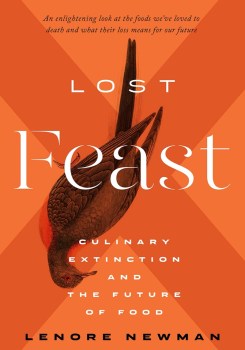The Very First Leftovers Were Made From Mammoth Meat
From this spring’s SciFri Book Club pick, learn how early humans developed concepts like dry-aging to make mammoth meat tastier and last longer.
This story is a part of our spring Book Club conversation about ‘Lost Feast: Culinary Extinction and the Future of Food.’ Want to participate? Join our new online community space or record a voice message on the Science Friday VoxPop app.
The following is an excerpt from Lost Feast: Culinary Extinction and the Future of Food by Lenore Newman.

Lost Feast: Culinary Extinction and the Future of Food
We can’t entirely know how quickly early humans eliminated mammoths once they entered an area, but we can glean clues from what we know of the mammoth’s habits and breeding. Studies of tusk show that when humans entered a herd’s territory, sexual maturity of female mammoths began happening earlier, a sign of predation we see today in stressed animal populations. (Climate change, on the other hand, would have had the opposite effect.) In some areas, we have found shelters built with mammoth tusks and bones, suggesting mass killing over a sustained period. Mammoths might seem fierce but were likely easy to sneak up on. A quick blow with a poisoned arrow or spear would do the rest, as they had weak points on their belly and neck. Such a bounty likely spurred the invention of an entirely new technology. As no group of humans could consume so much meat while it was fresh, there would have been a need to preserve some of the kill for a later time. Archeological evidence suggests humans weighted mammoth meat and submerged it in cool ponds, where it would stay somewhat fresh. Later, the earliest food technologies—smoking, drying and salting—emerged to protect similar meaty bounties. From such hunting, we developed the first really critical culinary skill after fire: leftovers.
We also know about mammoths from ancient cave art. Some ancient cave complexes were both shelters and the first places of worship. Rouffignac cave in France, known as the cave of the hundred mammoths, is a good example. To get to the farthest decorated chamber is a 45-minute walk underground. Oxygen levels are low and ancient artists would have been working by the flickering light of wicks floating in burning oil. Paintings of mammoths, woolly rhinoceroses, horses, bison, and other animals adorn the ceiling. Its location deep underground has protected the cave from light and the elements, giving us a good idea of the look and color of the live animals. Some are depicted at a run, galloping across the walls. The artists engraved lines into the rock and filled areas with pigment. Mammoths dominate the art, suggesting their great importance.
It is hard to say with certainty how we cooked mammoth, but archeologists can give us a rough idea. We had controlled fires a million years ago, though cooking pots didn’t develop until 20,000 years ago, and our mammoth snacking days fall somewhat in between. We had sharp stone knives and probably cut meat into chunks or strips to roast over or alongside the fire. The people of the Pacific coast of North America roasted salmon in thin strips by wrapping them around wooden sticks and planks and propping the planks near a fire, a technique that would work for mammoth as well. The fat would run over the meat and could be collected in shells at the bottom of the sticks. It is unlikely our mammoth chefs had much salt, but from dental plaque studies, we know the mammoth hunters ate herbs, and so perhaps they prepared a crushed herbal rub to massage into the meat. Today’s barbecue techniques have a very long pedigree.
An early human site in the Ukraine revealed a diet rich in plants and mammoth and signs of frequent cooking. Cooking causes meat to lose calories as the fat melts out, but it is easier to digest, reducing the caloric cost of digestion by as much as 15% and giving humans another critical edge. Early humans didn’t know that, of course, but they did know that cooked meat tasted better. One reason for this is known as the Maillard reaction, in which sugars and amino acids react to produce compounds that make seared foods tasty. Once early humans got a taste of caramelized mammoth with wild thyme, they were likely hooked.
The last species of the genus was the woolly mammoth, and these animals began to die off as humans followed the retreat of the glaciers. By 10,000 years ago, they were gone from the continents. On the remote Wrangel Island north of Alaska, a site that humans never colonized, the final pygmy mammoths vanished about 1650 BCE. These mammoths were never hunted but encountered a different problem: climate change. As the sea level rose, their habitat shrank until, eventually, the environment couldn’t support them.
The loss of the mammoth and similar animals left us with a problem: without megafauna, humans were hungrier and weaker. Our numbers contracted and our territories shrank. We needed a new way of interacting with the environment. Mammoth was off the menu.
You can read the rest of this chapter from Lenore Newman’s Lost Feast here.
Excerpted in part from Lost Feast: Culinary Extinction and the Future of Food by Lenore Newman © by Lenore Newman. Published by ECW Press Ltd.
Lenore Newman is the Director of the Food and Agriculture Institute at the University of the Fraser Valley in Canada, holds a Canada Research Chair in Food Security and Environment at UFV, and is a member of the Royal Society of Canada’s New College. She has a PhD in Environmental Studies from York University and has written two books, Lost Feast: Culinary Extinction and the Future of Food (2019) and Speaking in Cod Tongues: A Canadian Culinary Journey (2017).